Posts Tagged ‘Retro’
-
Q-BLOCK: Create 3D Pixel Art Online
27th Aug 20095Aww this is just too much fun! Take a 2D sprite, extrude it into 3D and then shave and tweak as required.
Voila, you’ve just described Q-BLOCK and created your first piece of 3D pixel art:
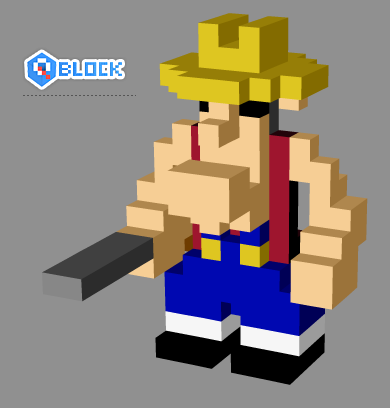
It’s cool pixel art, in 3D (rotation under you control). And you can edit any model you like, change the colours or just add on new parts.
I had a very similar idea to this years ago, and never bothered to do anything with it. I built a small prototype app in DarkBASIC that would build a 3D model from a 2D sprite. But the Q-BLOCK guys have gone a whole step beyond that, and it rocks.
Check out their blog for some excellent examples of insanely good Q-BLOCKery.
-
Spectrum Games Bible
18th Aug 2009
I was really excited to receive another couple of books in The Spectrum Games Bible series today. It’s a series of 6 books that present screen shots and mini community written reviews of 1,200 Sinclair Spectrum games released between 1982 and now. Editted and compiled by Paul Johns and Michael Fraser these are fascinating reads.
I love just picking a book and opening it on a random page to see what retro gaming delight (or howler!) will greet me. The games are presented by year and alphabetical order, with a neat index at the back of each should you wish to locate something specific.
Game reviews are often quite short, but for some span a page or two. Nearly all of them have screen shots which really help to jog the old grey matter. As the reviews are written by community members they vary in quality. Some are a little too introspective, focusing on the life story behind that particular game for the reviewer, rather than the game itself. But overall they are still a great read. I’d strongly recommend them to anyone who has an interest in retro gaming, or Flash game development today – as they are a gold mine of ideas and concepts.
The books vary in price as they are printed and delivered by lulu.com, so the higher the page count, the more it costs. The print quality is excellent and the colour covers a nice touch. Layout is clean and clear and I had no printing issues with any of them. If you are extremely flush with cash then you can buy full-colour editions, which have all screen shots in full colour internally. The cost of these editions ranges from between £40 and £70, with postage on-top! However the ones I (and I dare-say most people) own are the colour cover with black and white internal pages. They are a far more reasonable £9 to £10.
Visit the web site for more details: http://www.spectrumgamesbible.co.uk
-
Octopod! One of my first ever games :)
17th Jul 2009While digging through a huge stack of old Atari ST disks I found one which contained a bunch of my first ever ST games and demos. Created with STOS these are extremely primitive pieces (even by the standards of the late 1980s!) but I found it amusing watching and playing them all the same.
My very first real game was called Octopod. It involved shooting octopus, which for no sane reason would drop a gold coin after they exploded in red meaty chunks. Shoot the coin and you got points. Don’t shoot the octopus fast enough and you lost a life. Playing the game back tonight I found it insanely hard! Either my reflexes are vastly reduced now, or it doesn’t run quite the same under emulation 😉
Eitherway I present you a video of Octopod (sans music, as Camtasia was being a dick re: recording inputs)
[swfobj src=”http://sandbox.photonstorm.com/octopod.swf” width=”660″ height=”478″]
At the start you will see it’s inside the STOS editor. At the time this was a quite nice place to work, and reasonably well featured. You could have memory resident programs loaded into membanks, so you could switch between say the compiler or sprite editor at the press of a few keys. The block across the top is where you’d assign a sequence of key commands to function keys. The nasty salmon colour scheme is my fault, the default was white text on black. Remember back then most of us coded using TV sets, so this could be quite painful after extended periods of time!
I do a “list” at the start so you can view the source code and have a giggle. Oh and yes, you had to use line numbers! Only with AMOS on the Amiga did they drop that restriction. You can find out loads more about STOS at the STOS Time Tunnel web site.
I’m now considering re-coding it in Flash as part of the GYM Board 30 minute challenge 🙂
-
Chameleons, Cupcakes & Sharks – Oh my!
29th May 2009After the frenetic workload that went into my last game Kyobi, I needed a break from development. Add to this an insane pile of “real life” coding work and I was finding it really hard to motivate myself to get on with something new. Working until 3am in the morning day after day does that to me.
So my own personal game projects bit the dust. I tried mocking-up an overhead tank shooter, but that didn’t get so far because I didn’t have a firm vision of where the game should go. I even tried doing a co-op breakout style game and failed to even finish this yet. But I’m not posting here to bitch about my lack of motivation. I’m posting to say what I’m doing about it 🙂
The answer can be summed-up in the picture below:
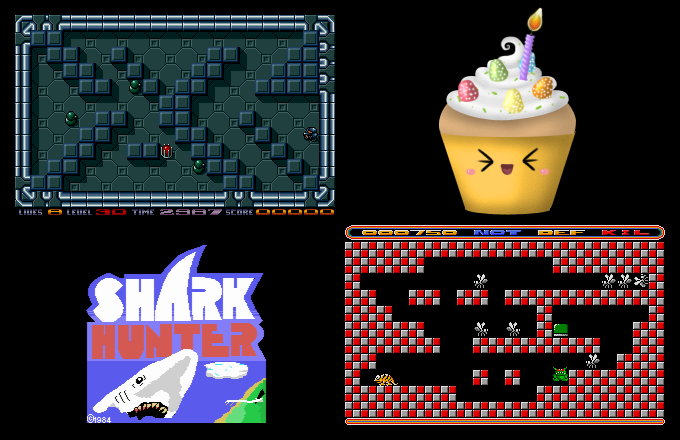
Here are four very different games. Top left is Robotz – a tactical / puzzle style shooter based on an Atari ST classic. Destroy the generators, this lets you destroy the robots (which are constantly chasing shooting at you). Destroy all the robots and the exit appears. It’s very simple, but actually really fun. The graphics are currently being pixelled for this, and I should have some level mock-ups to show next week. I’ve already done the level designer, mapped out 30 levels and have the soldier running around happily shooting at generators.
Bottom left is Shark Hunter. This was an awesome 8-bit MSX game. You had to mend your fishing nets, while fighting off the sharks and try to survive a whole year. Another nice simple game mechanic, but it has stood the test of time well, and I feel it’ll convert into Flash with ease. And hey, who doesn’t like spearing sharks? Concept graphics work for this is under-way, although no code has been written yet.
Top right is a cup cake. I have a really nice and innovative idea for a time-management game, that I have not seen done before. So I can’t give out too many details at this stage. But I think it could be a real success. I’ve got some awesome graphics through, and I’m actually toying with the idea of doing several games using the same assets – the time management one being the core, and then some simple spin-offs like a “spot the difference” style game, or a “cup cake dress-up”. Hey, you never know 🙂
Finally bottom right is a wonderful game that I loved on the ST. It was called Color Clash and was a PD game by Animal Soft. I doubt I’ll keep the same name as I don’t feel it does the game justice. You play the role of a chameleon who (as you’d expect) can change colour. Different colours have different actions. The yellow one can jump. The green one has a tail that he can flick to smash blocks / baddies. The red one inflates and floats and the blue one has a tongue that shoots out and can slide blocks around. I’m taking this core mechanic which works so well and tarting it up big-time.
40 levels have been designed already, and I’ve got the chameleon charging around the levels happily. Jumping, falling, sliding. Still need to do the baddie logic and colour changes. I want to do the original justice, but it also needs bringing up to date, so I’ll be refining and tweaking as I go. Still trying to track down the original author for his blessing on this project. Wish me luck.
I am working on Color Clash and Robotz at the same time. I quite like having the two projects to swap between. The other night I was stuck in getting my chameleon to jump-slide properly, and rather than admit defeat (for the night) and fire-up Left 4 Dead, I hit Robotz instead and got the shooting rebounds working smoothly. I’m also finding as they’re both similar 2D styled games, that I can share quite a bit of the code between them. Always a bonus.
So which will come out of the gates first? Honestly not sure. Right now Color Clash is the most complete, but has a lot of graphics work to be done to it. So Robotz may head it off at the final strait. Time will tell …
-
Announcing Turbo Stripe Software
25th May 2009I was digging through some boxes in our attic when I came across an old folder. It contained computer magazines and comics I had made back in the mid 1980s, aged around 10 years old. I used to sit there and literally draw my own magazines. I’d draw the covers, the layout, even screen shots for the games I was reviewing. One such magazine I called Arcade & Software. Very much inspired by Computer + Video Games (C+VG) of the mid 80s:

Here is the cover of issue 1. I only ever made 2 issues. The two games I’ve drawn on the cover are Knight Tyme (on the left) and Alien 8 on the right. Not that the robot looks a thing like the robot in Alien 8 mind you.
While flicking through Arcade & Software what caught my eye however was the inclusion of the Turbo Stripe Sofware Catalogue. This catalogue contained a list of games that as a 10 year old I really wanted to be making myself, complete with box cover artwork, short descriptions and even prices and ordering instructions.
These games never existed, I didn’t actually code them back then. I simply wasn’t capable of doing so at that age. It would be a couple more years before I started programming for myself. Reading through this fictitious catalogue there was something captivating about knowing that several decades ago this is what I really wanted to be doing. And these were the sorts of games a 10 year old me wanted to making.
So you know what? It’s time to fulfil a small part of that childhood dream and actually make one of those games. But which one? To decide let’s push embarrassment aside for a moment and dive right in …
… I present to you, in all its time-warped yellow-sellotaped glory the Turbo Stripe Software Catalogue (1987). Please excuse the horrendous spelling. And I claim no responsibility for copyright infringement re: the game ideas shown.
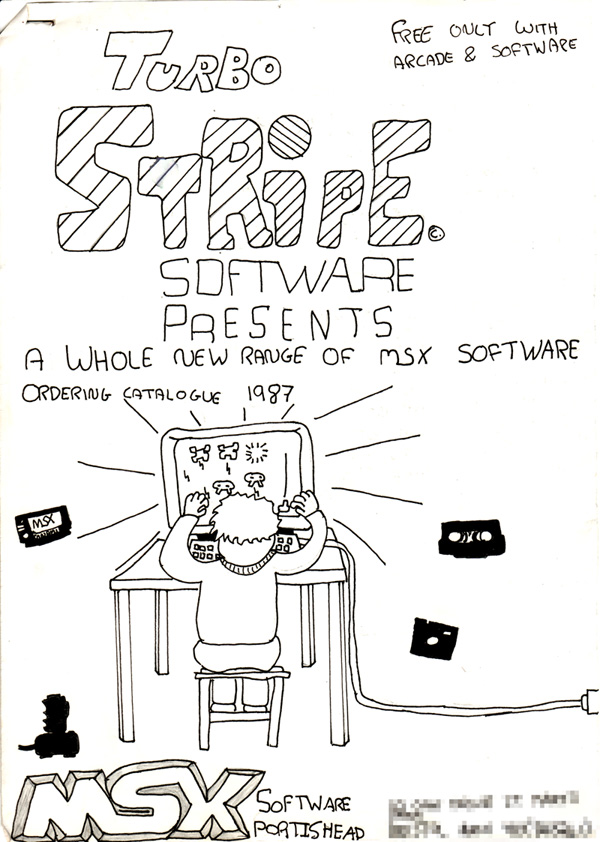
So here’s the front cover. The first thing to explain is that as a child I owned a Toshiba MSX 8-bit computer. In hindsight this was an incredible machine. It had a built-in cartridge port for which you could get some amazing games from the likes of Capcom and Konami. Games such as Nemesis (Gradius), Road Fighter, Sky Jaguar and Castlevania. It also had a tape recorder for the cheap tape-based games from Mastertronic, Ocean, Gremlin and other software houses of the day.
It was a great computer, even if virtually no-one else owned one (which made acquiring games in the school playgroup extremely difficult).
Obviously the kid playing on the MSX on this front cover is doing so with some kind of advanced invisible Wiimote. Turning the page …
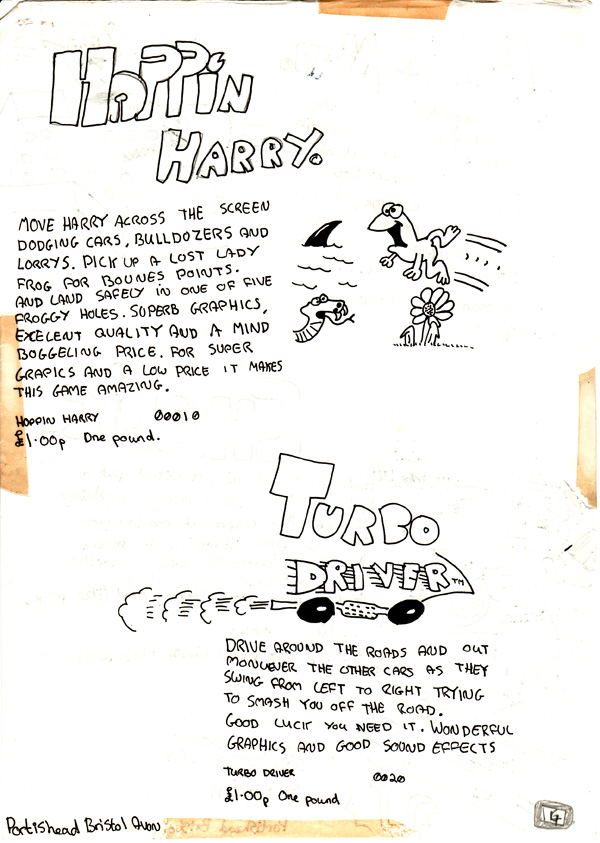
And here we have the first two games. I’ll give you no clues as to what Hoppin Harry was going to be a clone of. As you can see collecting the “lady frog” would net you “bounes points” [sic]. I think the 00010 number is the ordering code. Obviously leaving room for another 99,000 or so titles of similar quality.
Turbo Driver was my version of the bastard child of Spy Hunter and Super Sprint. Needless to say this would have incredible graphics too (at least I managed to spell that correctly this time). I’m not entirely sure how this game would play or look, I think it’s just filling space to be honest 🙂
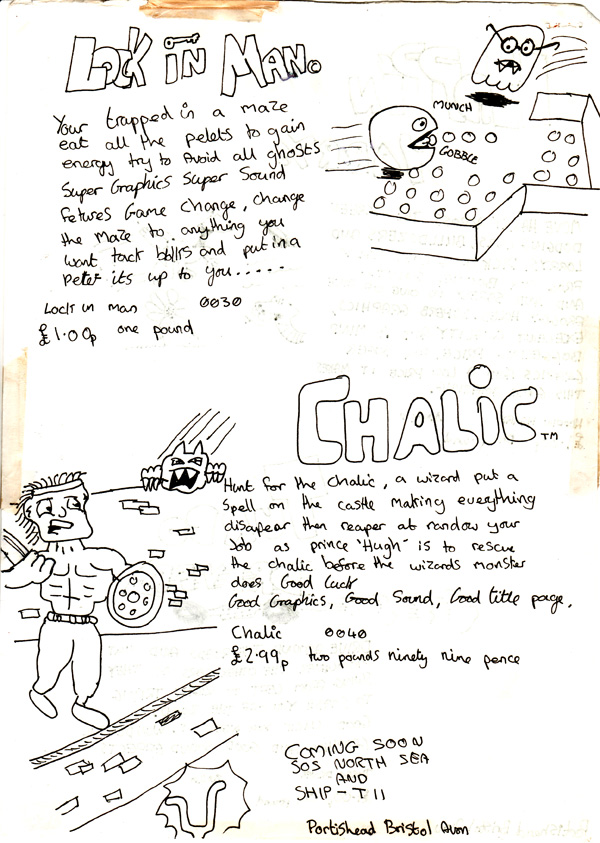
Ahh the classic Lock In Man. No, it has nothing to do with after-hours at a pub/bar. Instead you are trapped in a maze with “pellets” to eat and ghosts to avoid. I’m not sure why I didn’t just call it Pacman and be done with it. The one thing I remember most about my plans for this game, and which is alluded to in the description, is that it would ship with a level editor. I always got bored of the single level layout of Pacman and figured it’d be fun to create your own. I still think there is a shred of inspiration in that idea. Perhaps the maze could literally change around you as you play? So it becomes not so much about reflex based survival as it does puzzle solving.
The final game in the catalogue is Chalic. That’s my 10 year olds spelling of chalice (i.e. a cup/goblet). This was going to be a hybrid Gauntlet / Rogue game with more fantasy RPG overtones. As you can read in the description you’d be trapped in an ever-changing maze, and are trying to rescue a chalice before the Wizards monster does. I’ve no idea on earth why a chalice would need “rescuing”. I mean it’s just a bloody cup. But obviously it was in danger. Maybe if the Wizard drank from it, the world would be forever enslaved and “Prince Hugh” would wither and die? Who knows. I wrote the damned thing and even my mind is still reeling.
It’s worth noting that “Chalic” was only going to have “good” graphics rather than “excellent”. I find it interesting that I wrote it would have a “good title page”. Obviously game title pages were very important to me at the time. And the more I reflect on that I realise that actually they still are important to me today. I will often spend a disproportionate amount of time on the title pages for my games.
Coming soon was SOS North Sea and Ship-T11. SOS North Sea was a blatant rip of Chop Lifter. Ship-T11 was just going to be a shmup, the T11 part being the name of my calculate I had at the time. I’m not including these two games as being eligible for creation.
Which of these four gems do I feel is worth of being converted to Flash? It’s a tough choice.. personally I’m favouring “Chalic”, but I’ll open this up to the couple of you insane enough to have read this far. Which would you like to play? 🙂
Hire Us
All about Photon Storm and our
HTML5 game development services
Recent Posts
OurGames
Filter our Content
- ActionScript3
- Art
- Cool Links
- Demoscene
- Flash Game Dev Tips
- Game Development
- Gaming
- Geek Shopping
- HTML5
- In the Media
- Phaser
- Phaser 3
- Projects
Brain Food




